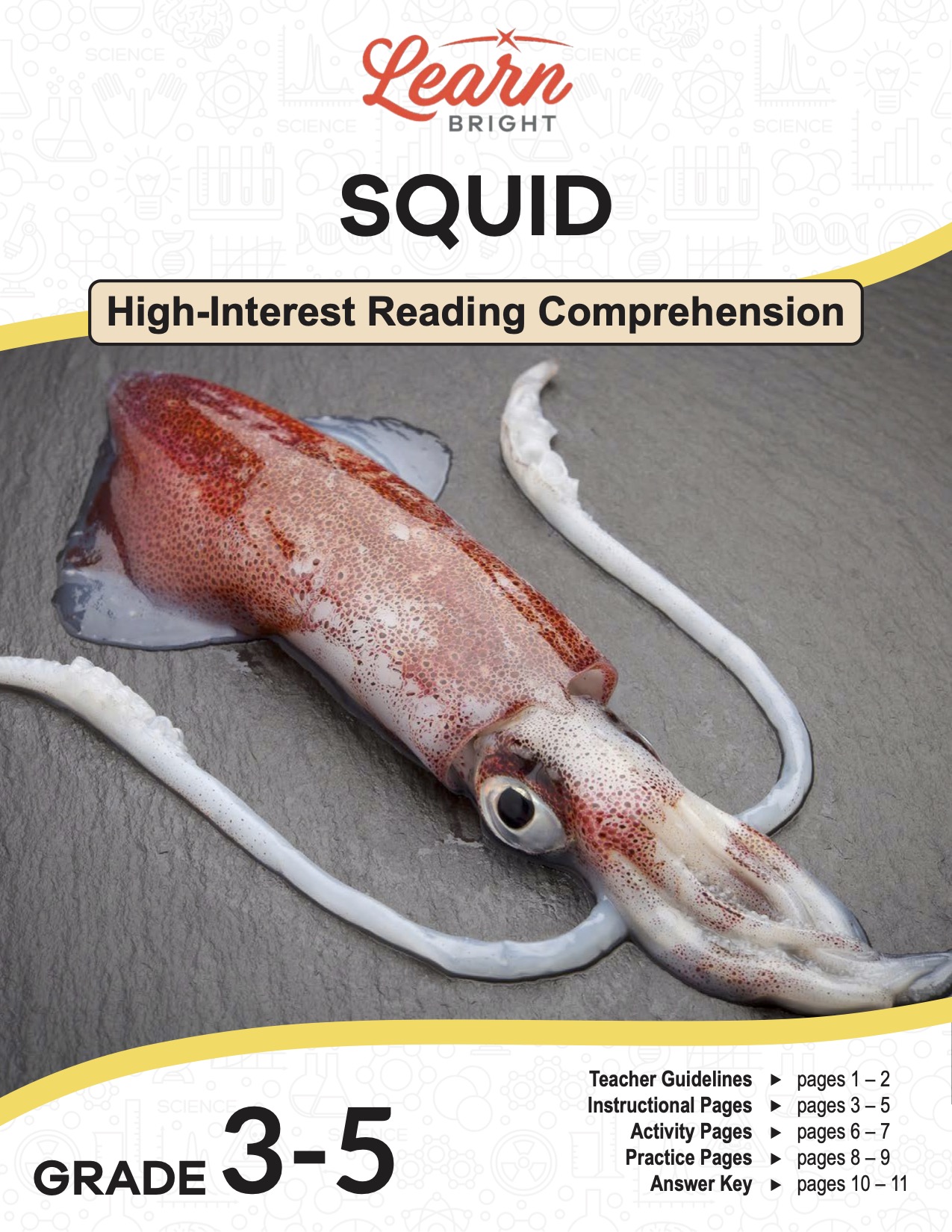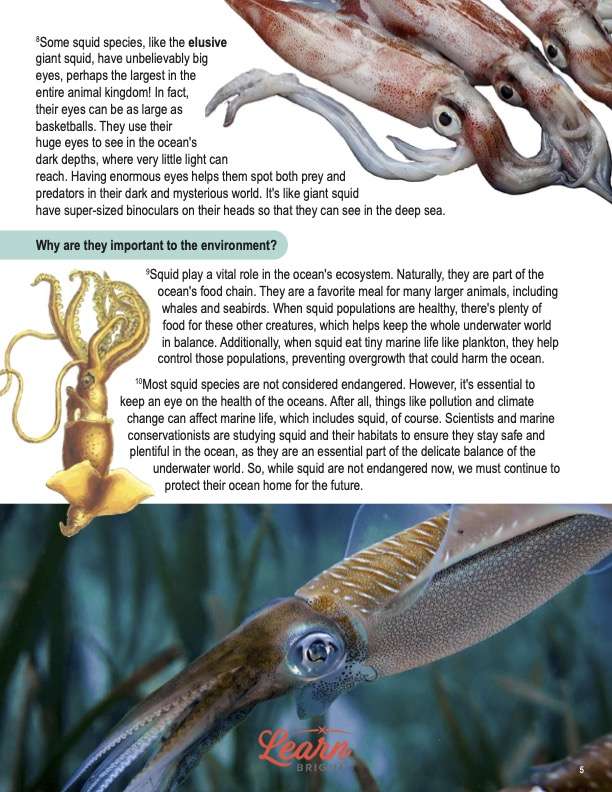Description
What our Squid lesson plan includes
Lesson Objectives and Overview: Squid is a high-interest reading comprehension lesson plan. As such, students will practice various close reading and comprehension skills. In addition, they will learn about the squid’s habitat, diet, and behaviors. This lesson is for students in 3rd grade, 4th grade, and 5th grade.
Classroom Procedure
Every lesson plan provides you with a classroom procedure page that outlines a step-by-step guide to follow. You do not have to follow the guide exactly. The guide helps you organize the lesson and details when to hand out worksheets. It also lists information in the yellow box that you might find useful. You will find the lesson objectives, state standards, and number of class sessions the lesson should take to complete in this area. In addition, it describes the supplies you will need as well as what and how you need to prepare beforehand. Find the list of supplies you need for the activity in the “Student Supplies” section of the this page.
Teacher Notes
The teacher notes page provides an extra paragraph of information to help guide the lesson and remind you what to focus on. It explains that you can teach this lesson in a whole-class setting or as an independent, small-group activity. The blank lines on this page are available for you to write out thoughts and ideas you have as you prepare the lesson.
SQUID LESSON PLAN CONTENT PAGES
What Is a Squid?
The Squid lesson plan contains three content pages. It begins by providing a box of background information about this animal. These cephalopods live in all the oceans and primarily eat shrimp and fish, as well as other small sea creatures. They generally live five to six years.
Squid are fantastic sea creatures with unique features. They have soft bodies and long, flexible arms covered in special suckers. These suckers help them catch prey and even attach to things in the ocean. Squid also have two big eyes, among the largest in the animal kingdom! These eyes help them see in the dark waters where they live. Squid are found in oceans worldwide, from the surface down to the dark and chilly parts. Some even glow in the dark, an ability called bioluminescence. It’s like having their very own underwater flashlight!
Like other creatures of the sea, squid are social animals that often live in groups called schools. Schools can have just a few squid or as many as thousands swimming together. Being in a school helps them stay safe from predators because there’s safety in numbers. When squid swim together, it looks like a troupe of ballet dancers twirling about in the ocean. They use their strong muscles to propel themselves through the water, escape from danger, or chase their prey.
Squid have a unique way of treating their young ones. When it’s time to lay eggs, female squid release them into the water. These eggs float near the surface and hatch into tiny baby squid, called squid larvae. Squid larvae are so tiny that they often become food for other creatures in the ocean. Only a few of them survive to become adults. Squid don’t take care of their babies as some animals do. Instead, they rely on producing many eggs so that at least a few can grow up and continue the squid family. It’s a bit different from how mammals like us care for our young, but it works well for squid in the deep, dark ocean.
What They Eat
When it comes to eating, squid are incredible underwater hunters. Their favorite foods are usually smaller sea creatures like tiny fish, shrimp, and smaller squid. Because they eat meat, that makes them carnivores. They use their long, flexible arms with those tiny suckers to sneak up on and grab their prey. These suckers have little hooks on them, called “rings of teeth,” which help the squid hold onto their dinner tightly.
Once a squid spots its next meal, it darts toward it with incredible speed and precision. It uses its tentacles to surround and grab the prey like a net. Then, the squid’s powerful beak—a complex and sharp mouth—helps it tear or chop its prey into smaller, bite-sized pieces. It’s similar to how you might cut your pizza into slices before eating it. For squid, chopping food into smaller pieces makes it easier for them to gobble up their meal. Their beaks are so strong that they can even crunch through the tough shells of crabs and other hard-shelled creatures.
Other Interesting Facts
Squid are like the race cars of the ocean because they have a unique way of swimming: jet propulsion. They have a body part called a siphon that helps them shoot water out with great force. By doing this, they can zoom through the water at impressive speeds. Think of it like a squid’s rocket engine! This ability helps them catch prey and escape from predators in the blink of an eye. As an added superpower bonus, they can shoot a dark cloud of ink in their predators’ faces and jet away.
Squid are experts of disguise, and they can change their colors and patterns to blend into their surroundings. They do this using chromatophores, which are tiny cells in their skin filled with colorful pigments. By expanding or shrinking these cells, squid can create an assortment of colors and patterns on their skin. They use this talent to hide from bigger fish or sneak up on their prey like sea ninjas. That’s no surprise from these stealthy hunters of the deep!
Some squid species, like the elusive giant squid, have unbelievably big eyes, perhaps the largest in the entire animal kingdom! In fact, their eyes can be as large as basketballs. They use their huge eyes to see in the ocean’s dark depths, where very little light can reach. Having enormous eyes helps them spot both prey and predators in their dark and mysterious world. It’s like giant squid have super-sized binoculars on their heads so that they can see in the deep sea.
Why Are Squid Important?
Squid play a vital role in the ocean’s ecosystem. Naturally, they are part of the ocean’s food chain. They are a favorite meal for many larger animals, including whales and seabirds. When squid populations are healthy, there’s plenty of food for these other creatures, which helps keep the whole underwater world in balance. Additionally, when squid eat tiny marine life like plankton, they help control those populations, preventing overgrowth that could harm the ocean.
Most squid species are not considered endangered. However, it’s essential to keep an eye on the health of the oceans. After all, things like pollution and climate change can affect marine life, which includes squid, of course. Scientists and marine conservationists are studying squid and their habitats to ensure they stay safe and plentiful in the ocean, as they are an essential part of the delicate balance of the underwater world. So, while squid are not endangered now, we must continue to protect their ocean home for the future.
SQUID LESSON PLAN WORKSHEETS
The Squid lesson plan includes two worksheets: an activity worksheet and a practice worksheet. Each one will help students solidify their grasp of the material they learned throughout the lesson. You can refer to the classroom procedure guidelines to know when to hand out each worksheet.
JET PROPULSION MODEL ACTIVITY WORKSHEET
For the activity, students will get to build their own jet propulsion models to simulate how squid move through water. They will need several supplies to complete the activity. First, they will follow the step-by-step instructions to build the model, fill the mantle cavity, and test the prototype. After the finish, they will answer the questions at the bottom of the worksheet.
SQUID PRACTICE WORKSHEET
The practice worksheet requires students to answer a series of 11 questions. These questions all relate to the content pages, so students will need to refer to them often for the answers. In addition, each question provides which reading tool the question corresponds to, such as text feature, vocabulary, or comprehension.
Worksheet Answer Keys
At the end of the lesson plan document is an answer key for the practice worksheet. The correct answers are all in red to make it easier for you to compare them with students’ responses. If you choose to administer the lesson pages to your students via PDF, you will need to save a new file that omits these pages. Otherwise, you can simply print out the applicable pages and keep these as reference for yourself when grading assignments.










